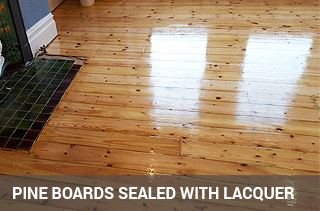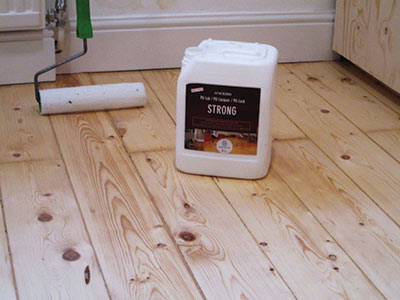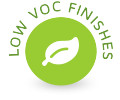Back to Flooring Products
Lacquer vs Varnish vs Polyurethane: Which Wood Floor Finish is Best?

When it comes to wood floor finishes, there are two main categories of products:
- Penetrating oil finishes – These soak into the wood’s porous structure, protecting from within while enhancing the natural texture and colour.
- Surface finishes – This group includes varnishes, lacquers, and polyurethane coatings, which form a protective film on top of the wood surface, shielding it from scratches, moisture, and wear.
In terms of durability and toughness, surface finishes are generally superior, offering robust protection for sanded and refinished floors in high-traffic areas.
In this guide, we'll explore the key differences between lacquer, varnish, and polyurethane finishes, explaining how each works, what they’re made of, and when to choose one over the others for your wooden floorboards.
What Is a Varnish?
The terms lacquer and varnish are often used interchangeably, but there are key differences between these wood floor finishes. While they share similar purposes — protecting the wood surface — they differ in composition, application, and durability.
In many cases, 'varnish' is used as a general term for any clear, protective surface coating. However, in flooring, varnishes have specific characteristics:
Main Characteristics of Varnish
- Transparent protective finish with a glossy appearance
- Composed of oil, solvent, and resin
- Different varnish types are created by varying the ratio of these components
- Harder but more brittle than lacquer, prone to cracking over time
When a varnish layer cracks, it loses its protective ability, allowing dust, moisture, and spills to penetrate and damage the wood. This tendency makes varnish less durable than modern lacquers in high-traffic and demanding environments.

What Is a Lacquer?
The term 'lacquer' originates from the Portuguese word for the lac insects (Laccifer lacca), whose secretions are historically used to create lacquer and shellac finishes. However, it’s important to note that lacquer and shellac are different products with distinct applications.
Main Advantages of Lacquer
- Softer and more flexible than varnish, making it less prone to cracking
- Better UV resistance, reducing discolouration over time
- Provides a durable, long-lasting seal on the floor surface
- Outperforms varnish in terms of durability and ease of maintenance
Due to its superior performance, lacquer has largely replaced varnish in modern flooring projects. Both products aim to protect and enhance wooden floors, but lacquer offers better longevity, flexibility, and resistance to environmental factors.
For more details on protective surface finishes, you can also explore our guide on wood floor finishes.
Buy Quality Wood Floor Lacquers
What Is a Polyurethane Finish?

Polyurethane finishes are among the most durable and hard-wearing options for protecting wooden floors. They come in two main variations:
- Water-based polyurethane
- Oil-based polyurethane
In terms of strength and longevity, polyurethane lacquers are often considered the strongest floor finish available for residential and commercial use. The only tougher alternative is aluminium oxide finishes, which are applied in factory settings and are not suitable for on-site applications.
Water-Based Polyurethane
- Low VOC content – safer for indoor air quality and human health
- Clear, transparent finish that preserves the natural wood colour
- Fast drying time, reducing project completion time
- Higher cost and slightly less durable compared to oil-based variants
Oil-Based Polyurethane
- Higher VOC content, requiring better ventilation during application
- Tends to yellow and amber over time, which can affect light or grey-stained floors
- Requires fewer coats for sufficient protection
- More budget-friendly option for large floor areas
When deciding between oil-based and water-based polyurethane finishes, factors like budget, desired appearance, drying time, and environmental considerations should guide your choice. For advice on the best finish for your flooring project, contact our wood floor restoration specialists.

Lacquer, Varnish, and Polyurethane: Which Is Best for Wood Floors?
While lacquers, varnishes, and polyurethane finishes are all still used in furniture finishing, their roles in floor finishing have evolved. Historically, varnishes were common for wooden floors, but they no longer meet the durability and flexibility required for modern flooring applications.
Lacquers, however, remain relevant in the flooring industry. Over time, the terms 'lacquer' and 'varnish' have become interchangeable, especially among the general public. Within the flooring trade, professionals continue to distinguish lacquers as the superior choice for surface protection.
It's important to understand that polyurethane is not a separate category of floor finish. Rather, it is a key ingredient used to enhance the performance of lacquers. Polyurethane lacquers offer the highest level of durability, making them the most sought-after option for protecting floorboards in both residential and commercial spaces.
For anyone seeking the best protective finish for wood floors, we strongly recommend considering polyurethane-based lacquers for their superior resilience, longevity, and finish quality.
To learn more about wood floor staining and finishing techniques, explore our service guides or get in touch with our wood floor restoration experts.
Comparison Table: Lacquer vs Varnish vs Polyurethane Finishes
| Feature |
Lacquer |
Varnish |
Polyurethane |
| Application |
Forms a surface film; modern spray-on or brush-on application |
Traditional brush application; an older method for floors |
Forms a durable surface layer; brush, roller, or spray applied |
| Durability |
Flexible, resists UV damage, less prone to cracking |
Hard but brittle, prone to cracking over time |
Highly durable, superior resistance to wear, moisture, and scratches |
| Appearance |
Glossy or matt finishes, enhances natural wood look |
Glossy, can yellow with age |
Clear, durable finish; oil-based yellows over time, water-based stays clear |
| Maintenance |
Easy to repair and recoat |
Difficult to repair once cracked |
Long-lasting with minimal upkeep |
| Best For |
Residential floors, modern interiors |
Furniture & traditional woodwork (no longer recommended for floors) |
High-traffic areas, commercial & residential floors |